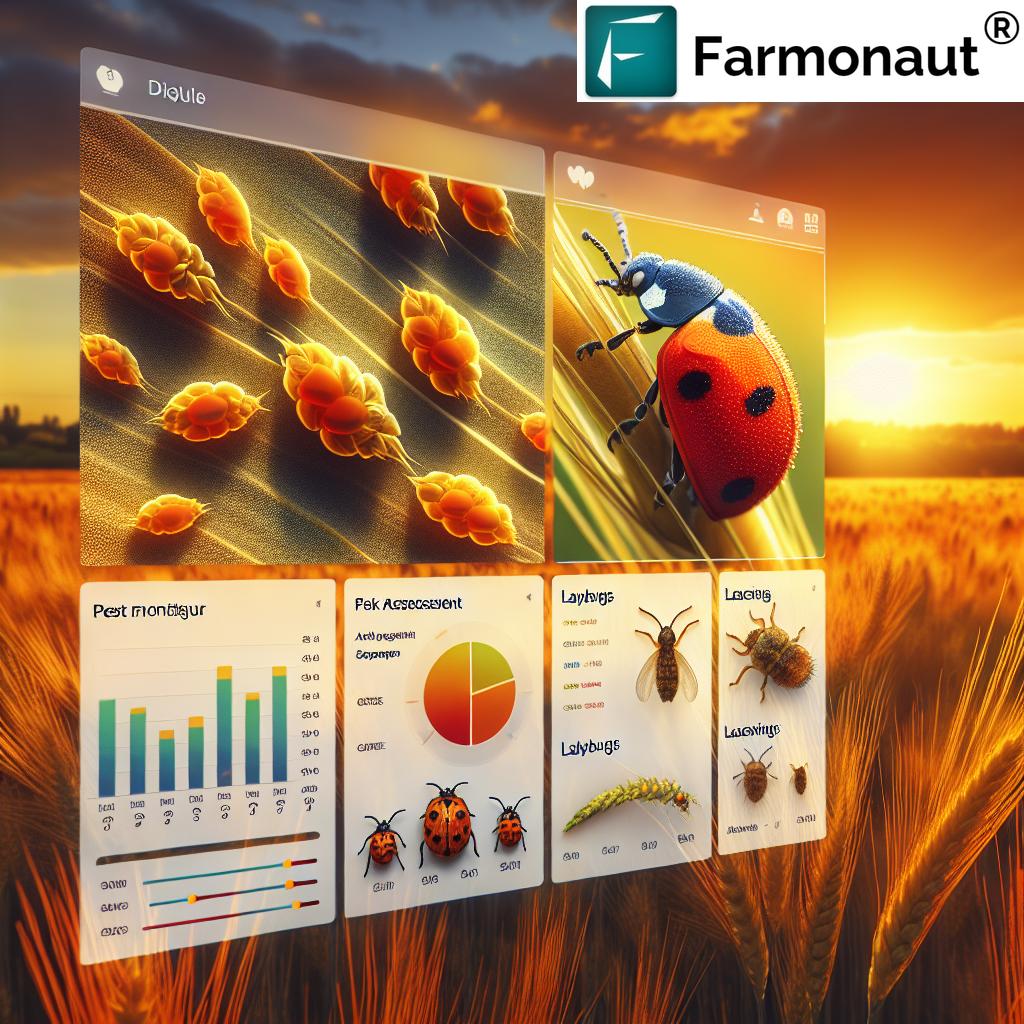Mastering Rose-Grain Aphid Control: Boost UK Cereal Crop Yields with Integrated Pest Management Strategies

“Rose-grain aphids can reduce cereal crop yields by up to 40% if left uncontrolled, highlighting the importance of effective pest management.”
Welcome to our comprehensive guide on mastering rose-grain aphid control in UK cereal crops. As experts in agricultural pest management and sustainable farming practices, we understand the critical importance of protecting your valuable crops from these persistent pests. In this blog post, we’ll explore effective cereal crop pest management strategies, focusing on the life cycle of the rose-grain aphid and the key risk factors that contribute to infestations. Our goal is to help you optimize your crop yields through integrated pest management techniques while promoting sustainable agriculture practices.
Understanding the Rose-Grain Aphid: A Threat to UK Cereal Crops
The rose-grain aphid (Metopolophium dirhodum) is a significant pest that poses a substantial threat to cereal crops across the UK. These tiny insects can cause extensive damage to wheat, barley, and other grains, leading to reduced yields and economic losses for farmers. To effectively combat this pest, it’s crucial to understand its life cycle and behavior.
The Life Cycle of the Rose-Grain Aphid
The rose-grain aphid has a complex life cycle that involves both primary (rose plants) and secondary (cereal crops) hosts. Let’s break down the stages:
- Overwintering: Eggs survive on rose bushes during winter months
- Spring Migration: Winged aphids emerge and move to cereal crops
- Summer Infestation: Rapid reproduction on cereal plants
- Autumn Return: Aphids return to roses for egg-laying
Understanding this life cycle is crucial for implementing effective control measures at the right time. By targeting the aphids during their vulnerable stages, we can significantly reduce their impact on cereal crops.
Risk Factors for Rose-Grain Aphid Infestations
Several factors contribute to the likelihood and severity of rose-grain aphid infestations in cereal crops. These include:
- Weather conditions (temperature and humidity)
- Crop health and vigor
- Natural predator populations
- Proximity to overwintering sites (rose bushes)
- Timing of crop planting and harvesting
By monitoring these risk factors, farmers can better predict and prepare for potential aphid outbreaks. This proactive approach is a key component of integrated pest management strategies.
Integrated Pest Management: A Sustainable Approach to Aphid Control
Integrated Pest Management (IPM) is a holistic approach to pest control that combines various strategies to minimize crop damage while reducing reliance on chemical pesticides. For rose-grain aphid control in cereals, IPM involves:
- Regular monitoring and scouting
- Encouraging natural predators
- Cultural control methods
- Targeted use of pesticides when necessary
Let’s explore each of these components in detail.
1. Monitoring and Scouting Techniques
Effective aphid control starts with vigilant monitoring of your cereal crops. Here are some key techniques:
- Visual Inspections: Regularly check plants for signs of aphid presence or damage
- Yellow Sticky Traps: Use these to detect winged aphids early in the season
- Sweep Net Sampling: Collect and count aphids to estimate population density
- Satellite-Based Crop Monitoring: Utilize advanced technologies for large-scale assessments
Farmonaut’s satellite-based crop health monitoring system can be an invaluable tool for detecting early signs of stress in cereal crops, which may indicate aphid infestations. By leveraging this technology, farmers can quickly identify problem areas and take prompt action.
2. Encouraging Natural Predators
“Integrated Pest Management strategies can increase natural predator populations by 30%, significantly reducing aphid infestations in cereal crops.”
One of the most sustainable methods of aphid control is to promote populations of natural enemies. These beneficial insects can help keep aphid numbers in check without the need for chemical interventions. Some important natural predators of rose-grain aphids include:
- Ladybirds (ladybugs)
- Lacewings
- Hoverflies
- Parasitic wasps
To encourage these beneficial insects, consider the following strategies:
- Plant flower strips or beetle banks around field margins
- Reduce broad-spectrum insecticide use
- Provide sheltered areas for overwintering
- Maintain diverse habitats near cereal fields
3. Cultural Control Methods
Cultural control methods involve modifying farming practices to make the environment less favorable for aphid populations. Some effective techniques include:
- Crop Rotation: Alternating cereal crops with non-host plants can disrupt aphid life cycles
- Adjusting Planting Dates: Early or late planting can help crops avoid peak aphid migration periods
- Resistant Varieties: Choose cereal varieties with natural resistance to aphids
- Proper Nutrition: Well-nourished plants are more resilient to aphid damage
- Field Hygiene: Remove volunteer cereals and grassy weeds that can harbor aphids
Implementing these cultural control methods can significantly reduce the risk of severe aphid infestations in your cereal crops.
4. Targeted Use of Pesticides
While integrated pest management aims to reduce reliance on chemical controls, there may be situations where pesticide use is necessary to prevent significant crop losses. When considering chemical control for rose-grain aphids, keep the following points in mind:
- Use selective insecticides that target aphids while minimizing harm to beneficial insects
- Apply pesticides only when aphid populations exceed economic thresholds
- Rotate between different classes of insecticides to prevent resistance development
- Follow all label instructions and local regulations for pesticide use
- Consider the environmental impact and choose products with lower toxicity when possible
Remember, pesticides should be used as a last resort within an integrated pest management framework. By combining monitoring, biological control, and cultural practices, you can often manage aphid populations effectively without relying heavily on chemical interventions.
Leveraging Technology for Precision Pest Management
In today’s digital age, technology plays a crucial role in enhancing our ability to manage pests effectively. Advanced tools and systems can provide valuable insights and support decision-making processes for farmers and agronomists.
Satellite-Based Crop Monitoring
Satellite imagery and remote sensing technologies offer powerful capabilities for monitoring crop health and detecting potential pest issues across large areas. Farmonaut’s platform utilizes multispectral satellite images to provide farmers with real-time insights into vegetation health, soil moisture levels, and other critical metrics.
By analyzing this data, farmers can:
- Identify areas of stress in cereal crops that may indicate aphid infestations
- Track the spread of pest problems across fields
- Assess the effectiveness of control measures over time
- Make informed decisions about when and where to apply pest management strategies
AI-Powered Advisory Systems
Artificial intelligence is revolutionizing pest management by providing personalized recommendations based on vast amounts of data. Farmonaut’s Jeevn AI Advisory System analyzes satellite data, weather forecasts, and other inputs to generate customized advice for farmers.
These AI-driven systems can help with:
- Predicting potential aphid outbreaks based on historical data and current conditions
- Recommending optimal timing for pest control interventions
- Suggesting the most effective integrated pest management strategies for specific situations
- Providing real-time alerts when pest thresholds are approached or exceeded
By leveraging these advanced technologies, farmers can take a more proactive and precise approach to managing rose-grain aphids in their cereal crops.
Economic Considerations in Rose-Grain Aphid Management
When implementing pest management strategies, it’s essential to consider the economic implications. The goal is to maximize crop yields while minimizing control costs. Here are some key economic factors to keep in mind:
- Economic Thresholds: Determine the point at which the cost of control measures is justified by the potential crop losses
- Cost-Benefit Analysis: Compare the expenses of different control methods against their expected benefits
- Long-Term Planning: Consider the cumulative effects of sustainable practices on soil health and future crop productivity
- Market Demands: Take into account consumer preferences for sustainably produced cereals
By carefully evaluating these economic factors, farmers can develop cost-effective strategies for managing rose-grain aphids in their cereal crops.
The Future of Cereal Crop Protection
As we look to the future, several emerging trends and technologies are shaping the landscape of cereal crop protection:
- Gene Editing: Development of aphid-resistant cereal varieties through advanced breeding techniques
- Biological Control Agents: Discovery and commercialization of new natural enemies and biopesticides
- Precision Agriculture: Integration of IoT sensors and drones for real-time pest monitoring
- Climate-Smart Farming: Adaptation strategies to manage changing pest dynamics due to climate change
Staying informed about these advancements can help farmers prepare for the challenges and opportunities that lie ahead in cereal crop pest management.
Conclusion: A Holistic Approach to Rose-Grain Aphid Control
Mastering rose-grain aphid control in UK cereal crops requires a multifaceted approach that combines traditional farming wisdom with cutting-edge technology. By implementing integrated pest management strategies, leveraging advanced monitoring tools, and staying informed about the latest developments in agricultural science, farmers can effectively protect their crops while promoting sustainable practices.
Remember, successful aphid management is an ongoing process that requires vigilance, adaptability, and a commitment to continuous learning. By working together and sharing knowledge, we can ensure the resilience and productivity of UK cereal crops for generations to come.
For more information on how Farmonaut’s satellite-based farm management solutions can support your pest management efforts, visit our website or download our mobile app today.
Explore Farmonaut’s API for advanced agricultural data integration
Access our comprehensive API Developer Documentation
Rose-Grain Aphid Life Cycle and Risk Factors
| Life Cycle Stages | Risk Factors | ||||
|---|---|---|---|---|---|
| Stage Name | Duration (days) | Key Characteristics | Factor Type | Impact Level | Management Strategy |
| Overwintering | 90-120 | Eggs on rose bushes | Plant Health | High | Proper nutrition and crop rotation |
| Spring Migration | 7-14 | Winged aphids move to cereals | Weather Conditions | Medium | Monitor temperature and humidity |
| Summer Infestation | 60-90 | Rapid reproduction on cereals | Natural Predator Populations | High | Encourage beneficial insects |
| Autumn Return | 14-21 | Return to roses for egg-laying | Crop Variety Susceptibility | Medium | Choose resistant varieties |
FAQs: Rose-Grain Aphid Control in UK Cereal Crops
- Q: What are the early signs of a rose-grain aphid infestation in cereal crops?
A: Early signs include yellowing or stunted growth of plants, curling of leaves, and the presence of honeydew (a sticky substance excreted by aphids) on leaves. You may also notice small green or pinkish insects clustering on stems and leaves. - Q: How do weather conditions affect rose-grain aphid populations?
A: Mild winters and warm, dry springs can lead to increased aphid survival and earlier migration to cereal crops. Conversely, cold, wet weather can reduce aphid populations and slow their spread. - Q: Can crop rotation help control rose-grain aphids?
A: Yes, crop rotation can be effective. By alternating cereals with non-host crops, you can disrupt the aphid’s life cycle and reduce overwintering populations in the field. - Q: What natural predators can help control rose-grain aphids?
A: Ladybirds, lacewings, hoverfly larvae, and parasitic wasps are all effective natural predators of rose-grain aphids. Encouraging these beneficial insects can significantly reduce aphid populations. - Q: How can technology like satellite imaging help in aphid management?
A: Satellite imaging can detect changes in crop health and vigor, which may indicate aphid infestations. This technology allows farmers to identify problem areas quickly and target their pest management efforts more effectively. - Q: Are there any resistant cereal varieties that can help combat rose-grain aphids?
A: Yes, some cereal varieties have been bred for increased resistance to aphids. Consult with local agricultural extension services or seed suppliers for information on aphid-resistant varieties suitable for your region. - Q: How often should I monitor my cereal crops for rose-grain aphids?
A: During the growing season, it’s recommended to check your crops at least once a week. Increase monitoring frequency during peak migration periods or when conditions are favorable for aphid development. - Q: What are the economic thresholds for initiating chemical control of rose-grain aphids?
A: Economic thresholds can vary depending on the growth stage of the crop and local conditions. Generally, treatment may be warranted when there are 5-10 aphids per tiller at the seedling stage, or 10-20 aphids per tiller later in the season. Always consult local guidelines for specific recommendations. - Q: How can I integrate cultural, biological, and chemical controls effectively?
A: Start with cultural controls like crop rotation and resistant varieties. Encourage natural predators through habitat management. Monitor aphid populations regularly and only use chemical controls when other methods are insufficient and economic thresholds are exceeded. - Q: What future developments in aphid control should UK cereal farmers be aware of?
A: Keep an eye on advancements in gene editing for aphid resistance, new biological control agents, and precision agriculture technologies. These developments may offer more sustainable and effective aphid management options in the future.

Farmonaut Subscriptions
















